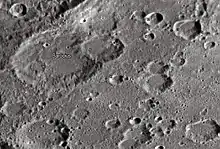Barocius (crater)
Barocius is an ancient lunar impact crater that is located in the rugged southern highlands of the Moon. It was named after Italian mathematician Francesco Barozzi.[1] It lies just to the southeast of the large crater Maurolycus. To the southwest of Barocius is Clairaut, and to the south-southeast lies Breislak.
 Lunar Orbiter 4 image | |
| Coordinates | 44.98°S 16.81°E |
|---|---|
| Diameter | 83 km |
| Depth | 3.5 km |
| Colongitude | 345° at sunrise |
| Eponym | Francesco Barozzi |
The rim of Barocius has been worn and eroded by countless subsequent impacts. Of these the most notable is Barocius B which lies across the northeast rim, and intrudes into Barocius C. There is a remnant of a crater, Barocius W, that lies just inside the southwest interior wall. On the interior floor is a low central peak offset to the north of the floor midpoint.
Satellite craters
By convention these features are identified on lunar maps by placing the letter on the side of the crater midpoint that is closest to Barocius.

| Barocius | Coordinates | Diameter, km |
|---|---|---|
| B | 44.13°S 18.29°E | 36,6 |
| C | 43.11°S 17.48°E | 35,8 |
| D | 46.06°S 19.18°E | 8,7 |
| E | 47.24°S 22.15°E | 23,6 |
| EC | 48.22°S 22.49°E | 7,7 |
| F | 45.92°S 21.60°E | 15,4 |
| G | 42.52°S 21.03°E | 27,6 |
| H | 46.71°S 21.63°E | 10,6 |
| J | 44.97°S 21.41°E | 27,2 |
| K | 45.22°S 19.63°E | 13,6 |
| L | 42.50°S 18.81°E | 13,0 |
| M | 42.45°S 19.48°E | 15,8 |
| N | 43.20°S 19.76°E | 10,1 |
| O | 45.75°S 21.93°E | 5,4 |
| R | 43.91°S 21.53°E | 14,3 |
| S | 42.50°S 21.82°E | 8,3 |
| W | 45.68°S 16.21°E | 18,9 |
References
- "Barocius (crater)". Gazetteer of Planetary Nomenclature. USGS Astrogeology Research Program.
- Andersson, L. E.; Whitaker, E. A. (1982). NASA Catalogue of Lunar Nomenclature. NASA RP-1097.CS1 maint: ref=harv (link)
- Bussey, B.; Spudis, P. (2004). The Clementine Atlas of the Moon. New York: Cambridge University Press. ISBN 978-0-521-81528-4.CS1 maint: ref=harv (link)
- Cocks, Elijah E.; Cocks, Josiah C. (1995). Who's Who on the Moon: A Biographical Dictionary of Lunar Nomenclature. Tudor Publishers. ISBN 978-0-936389-27-1.CS1 maint: ref=harv (link)
- McDowell, Jonathan (July 15, 2007). "Lunar Nomenclature". Jonathan's Space Report. Retrieved 2007-10-24.CS1 maint: ref=harv (link)
- Menzel, D. H.; Minnaert, M.; Levin, B.; Dollfus, A.; Bell, B. (1971). "Report on Lunar Nomenclature by the Working Group of Commission 17 of the IAU". Space Science Reviews. 12 (2): 136–186. Bibcode:1971SSRv...12..136M. doi:10.1007/BF00171763.
- Moore, Patrick (2001). On the Moon. Sterling Publishing Co. ISBN 978-0-304-35469-6.CS1 maint: ref=harv (link)
- Price, Fred W. (1988). The Moon Observer's Handbook. Cambridge University Press. ISBN 978-0-521-33500-3.CS1 maint: ref=harv (link)
- Rükl, Antonín (1990). Atlas of the Moon. Kalmbach Books. ISBN 978-0-913135-17-4.CS1 maint: ref=harv (link)
- Webb, Rev. T. W. (1962). Celestial Objects for Common Telescopes (6th revised ed.). Dover. ISBN 978-0-486-20917-3.CS1 maint: ref=harv (link)
- Whitaker, Ewen A. (1999). Mapping and Naming the Moon. Cambridge University Press. ISBN 978-0-521-62248-6.CS1 maint: ref=harv (link)
- Wlasuk, Peter T. (2000). Observing the Moon. Springer. ISBN 978-1-85233-193-1.CS1 maint: ref=harv (link)
